At the time when protecting the planet usually means restrain—less air conditioning, less heating, less sauna, less car, less shopping, no no to overseas holidays—gardening offers a welcomed respite. Because in the garden, the more rambunctious we are, the better. Yet, it is easy to get overwhelmed by stern voices advising planting rigour. We hear to use only native plants, cherish nettles, or remove showy cultivars in favour of more modest species varieties. But is it really necessary? Is it possible to create a wildlife friendly garden without sacrifices?
To cut the long story short, these are the three simple rules for creating a wildlife-friendly garden the easy, yet powerful, way:
- Plant, plant, plant. And then plant.
- Plant whatever you fancy on the condition it can grow in your garden without too much interventions.
- Dream, experiment, learn, and have fun.
Below I explain why acting by these simple rules can make a real difference for the environment and for your wellbeing simultaneously.
Wildlife-friendly by the righteous gardener
There are common themes going through the majority of articles on sustainable, wildlife-friendly gardens I am coming across. The first is a native plants dogma, which translates into using exclusively species that naturally grow in the area.
The second most common precept is to avoid cultivars with more complex flower structures. These are usually more attractive to people—though the beauty lies in the eye of beholder—but more difficult or straight impossible for insects to get access to pollen or nectar. Cultivars may also serve poor quality pollen and nectar. This is because during artificial selection for the looks, evolutionary adjusted traits which are of value for pollinators may be lost. Therefore, a righteous gardener sticks to what evolution had perfected and avoids hybrids, full roses and the likes.
The third major restriction – more a mental state than a practical advice – is to forgo our love for order in favour of serving the higher purpose. It may seem that the only way to meet biodiversity goals is to leave patches of the garden for weeds, let rotten wood all over the place, install swampy pond, and generally embrace the derelict look.
…
The pitfall of perfectionism and a 3-minutes cure
The above list, which could, of course, be supplemented by an almost endless set of additional rules, is a guide for seemingly perfect insect-oriented garden. Leaving aside the discussion whether it is indeed ideal, or whether such space is still a garden, ‘perfect’ does not always equal attainable.
I usually act on premises that if something is worth doing at all, it is worth doing well. In principle, it is a good attitude resulting in a good quality work. But perfectionism sometimes becomes damaging because I get too serious and lose all fun before even properly trying things out. I might even abandon ideas at an initial step when my skills or knowledge are in their infancy. What if I cannot do that perfectly? Perfectionism also means overdoing things that don’t really need to be perfect. Besides, what is perfect?
Exactly. What is perfect?
The 3-minutes rule
Somewhere long ago, in my vibrant youth, I signed up for yoga classes. I suddenly felt so much lighter that I tried to do a session everyday, which might be challenging when you are a PhD student at a research lab. Sometimes I just didn’t have energy or discipline, or patience, or whatever, for a full session. That is when I discovered a 3-minutes rule: 3 minutes of yoga were better than nothing. I might not have been in a mood for 1 hour or not even 15 minutes. But 3 minutes were easy to pull off and made me feel genuinely better. Moreover, after 3 minutes I could decide whether I want more or not. Now I exercise essentially every day, and on days I don’t feel like doing anything, I do only 3 minutes. I do feel better afterwards. On those days, 3 minutes is perfect.
Something is better than nothing is an immensely useful concept to embrace. Because there are situations when something is all that can be accomplished. And yet, the little something still can be very powerful.
Three principles of the easy-going wildlife-friendly garden
1. Plant abundance
Reasonably, native plants support local creatures best and are particularly important for larval (for example caterpillar) stages of insect’s life. However, the benefits of native flora depend on lots of circumstances and in many cases using solely native species is not crucial for animal diversity and abundance. Note, I don’t intend to sieve science from automatically repeated claims at the moment, and how large that margin of benefit is. Or, from another angle, how detrimental is mixing of non-native species into planting. These topics are so complex that deserve a separate post.
However, if there is one principle to creating a wildlife-friendly garden, the sheer amount of vegetation is the most important guideline to follow. Biomass is the most relevant factor for supporting abundance of animals. So the 3-minutes in garden making translates into plant, plant, and once more PLANT. Furthermore, the more plant species and wider vertical range—ground cover, shrubby layer and trees—the more animal diversity.
2. Choose plants that are happy with what you have
Don’t worry what you plant as long as the second principle is adhered to as well: choose plants appropriate for the local soil, drainage, aspect (that is, available sunlight) and climate conditions. Otherwise you are going to swim against the current, and even resort to spraying or other totally counterproductive practices to support weak plants. Chemical pest control invariably kills, along with the target pest, that same wildlife we try to protect. No matter what is written on the package. Consider that a variety of wildlife requires a variety of plant species, not only those which grow on fertile soils. That means that poor soil does not require vast amounts of amendments, but a sensible plant choice.
3. Plant what you enjoy
It is unhealthy to go bankrupt on supporting charities, but donating excess for greater causes is graceful. Along this lines, garden for yourself, but share the bounty if you can. If you aim for more than feels comfortable or feel guilty about your roses, the garden might become another chore instead of relaxing space and nourishing activity. On the other hand, if you set up a garden that you want to be in, the garden in which you anticipate every next season, you will have motivation to put an effort into design and maintenance. You are likely to test new ideas, because it is our human way to strive for more when rewarded. You will be happier and thus make everybody around you feeling better, which makes more happy people who have a head space to change something. This might sound woo, but is pragmatic to the core.
These are fairly straightforward and very relaxed rules. How following just this minimum formula can lead to a holy grail of supporting biodiversity? Probably the most cited example is the story of a traditional mixed border at Great Dixter. However, dear reader, you might feel that estate garden is not reflecting the average private garden. Instead, I will show what is possible by examples from my tiny urban property.
“Small oceans make big, big waves”
Pearl Jam, Tremor Christ
How does it work? Urban case study
When we moved into our current premises—new development of apartment houses with small gardens around blocks—the area was almost an ecological desert. Freshly build up with no retained original vegetation except one tired tree: no bird, no bee, no grasshopper, not even a spider visited the quarter. The only source of sounds were people. Small gardens were eventually—by universal western standard—seeded with turf grass, surrounded by hornbeam hedges and adorned with a few classical landscape shrubs.
The beginning of a garden—the beginning of a living system
For the first two years, we only had a few shrubs and small patches of cosmos and poppies, but most of the garden was covered with a pathetic lawn over compacted soil. Finally, we removed the struggling turf on a third of our ~150 sq.m property, and planted it with a herbaceous border. Life started appearing. Shyly at first. The first explorers were bees, hover flies, butterflies and various crawlers. Earthworms, which arrived as stowaways with seedlings, multiplied under mulch to a legion, improving the poor structure of the soil. The second season, I started enjoying grasshoppers chirping, which for me is the sound of summer. Then other visitors came.
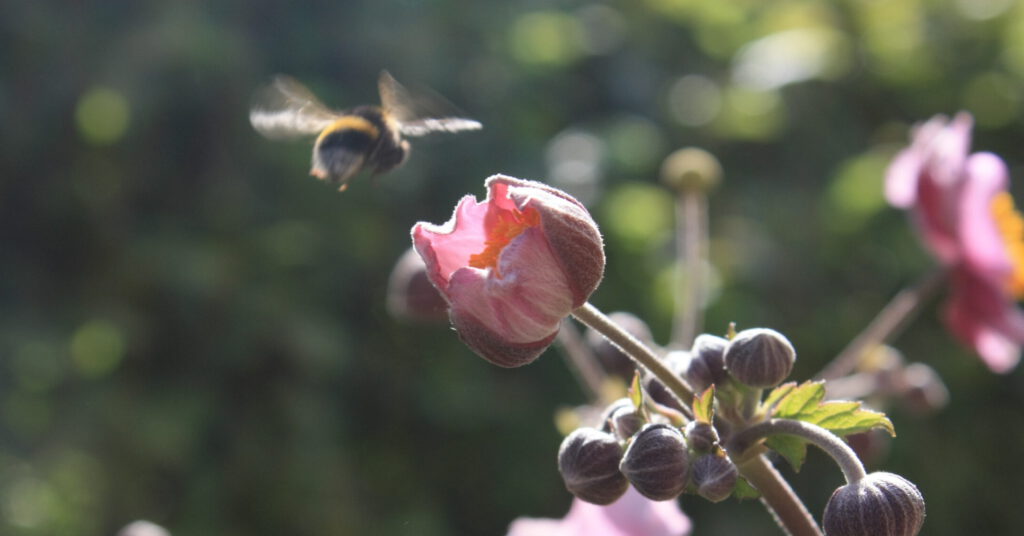
Harescape
I will be honest: I planned our garden with our enjoyment in mind. It turned out, though, the garden quickly attracted unexpected cohabitants. In the second vegetation season—less than a year from the planting—our garden become a nursing home for 3 leverets (little baby hares). The mother hid them right in front of our terrace, between immature tussocks of Sesleria and Pennisetum within about 3 m-wide flower border. A frequently used public path goes along the other side of the hedge. I could watch them from the kitchen window grooming themselves (most of the time), sleep (remarkably little) and hop around (sometimes). One of the bunch was particularly adventurous and discovered that a corner of our terrace behind a broom is an excellent safe—and dry!—spot to overnight.
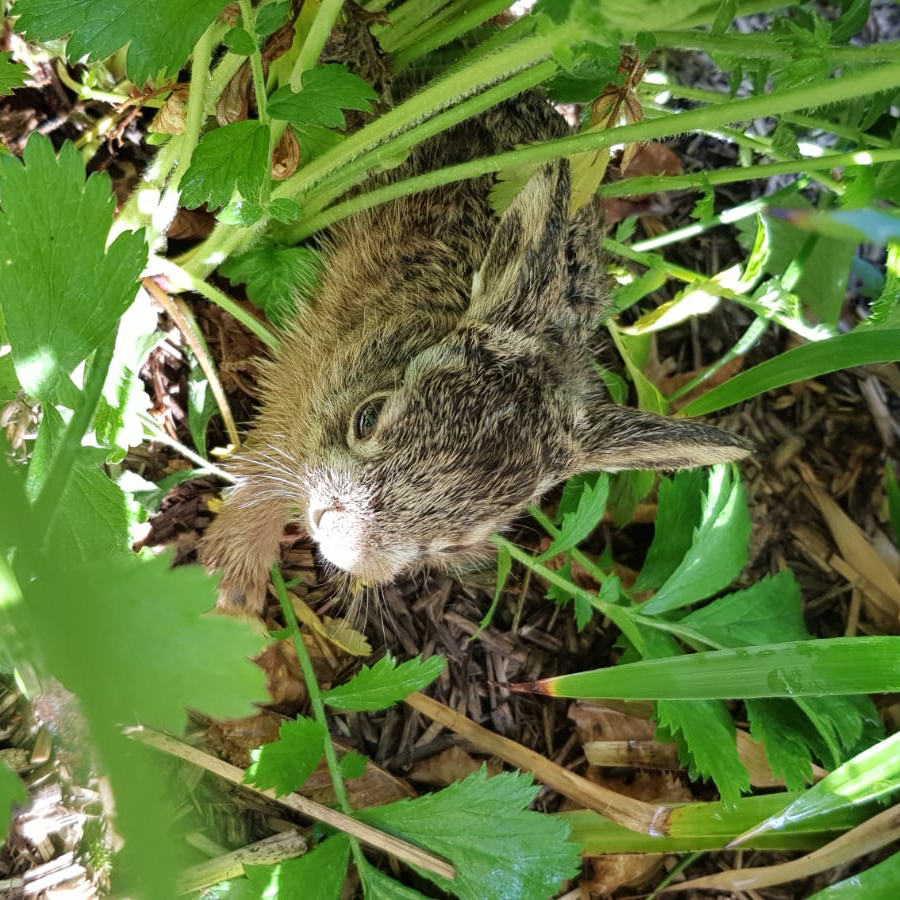
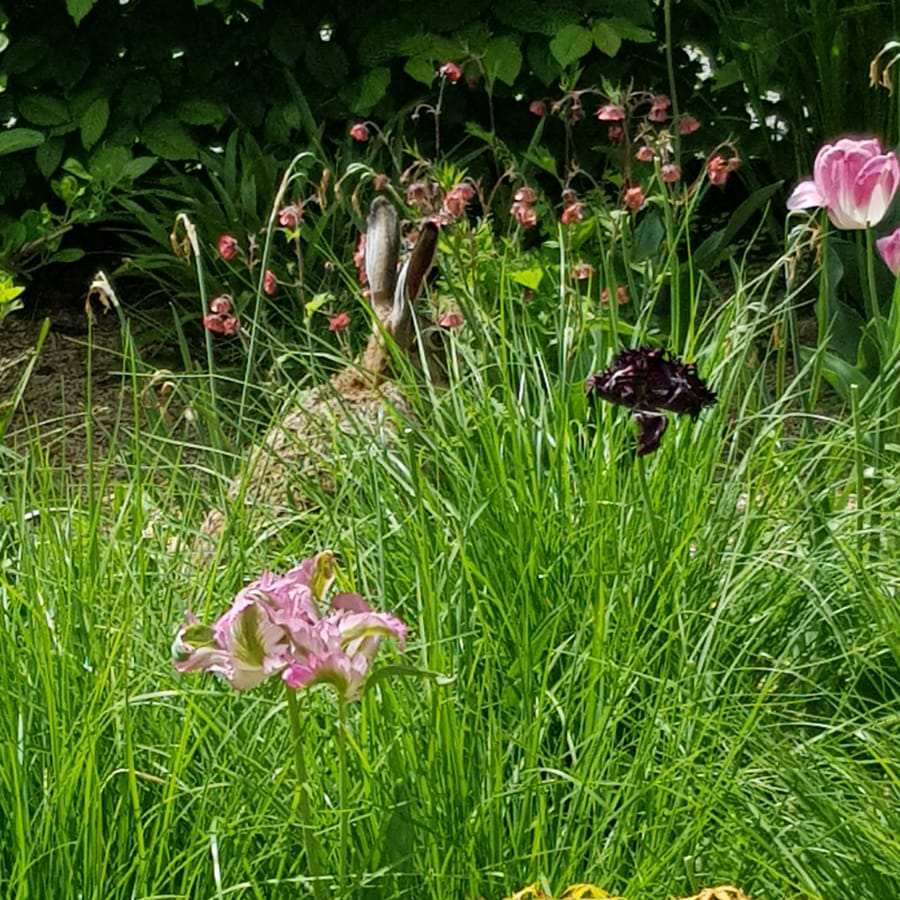
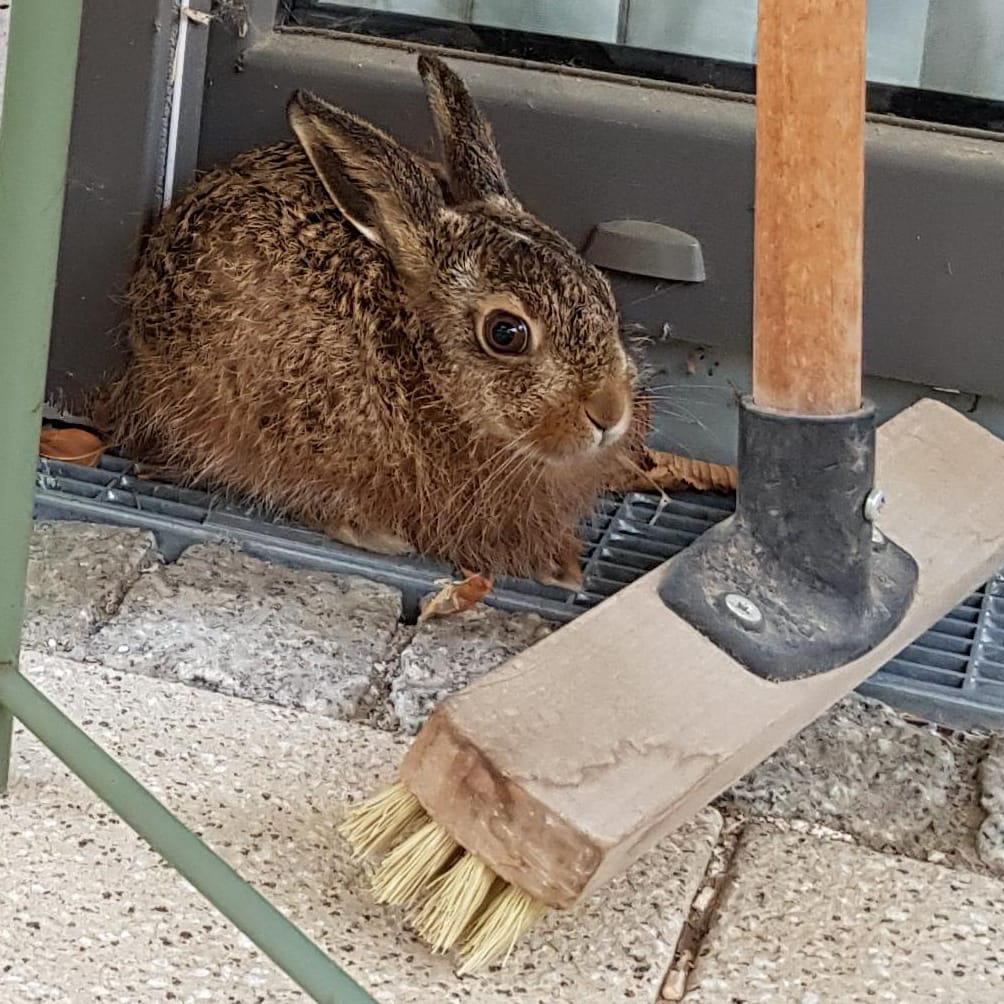
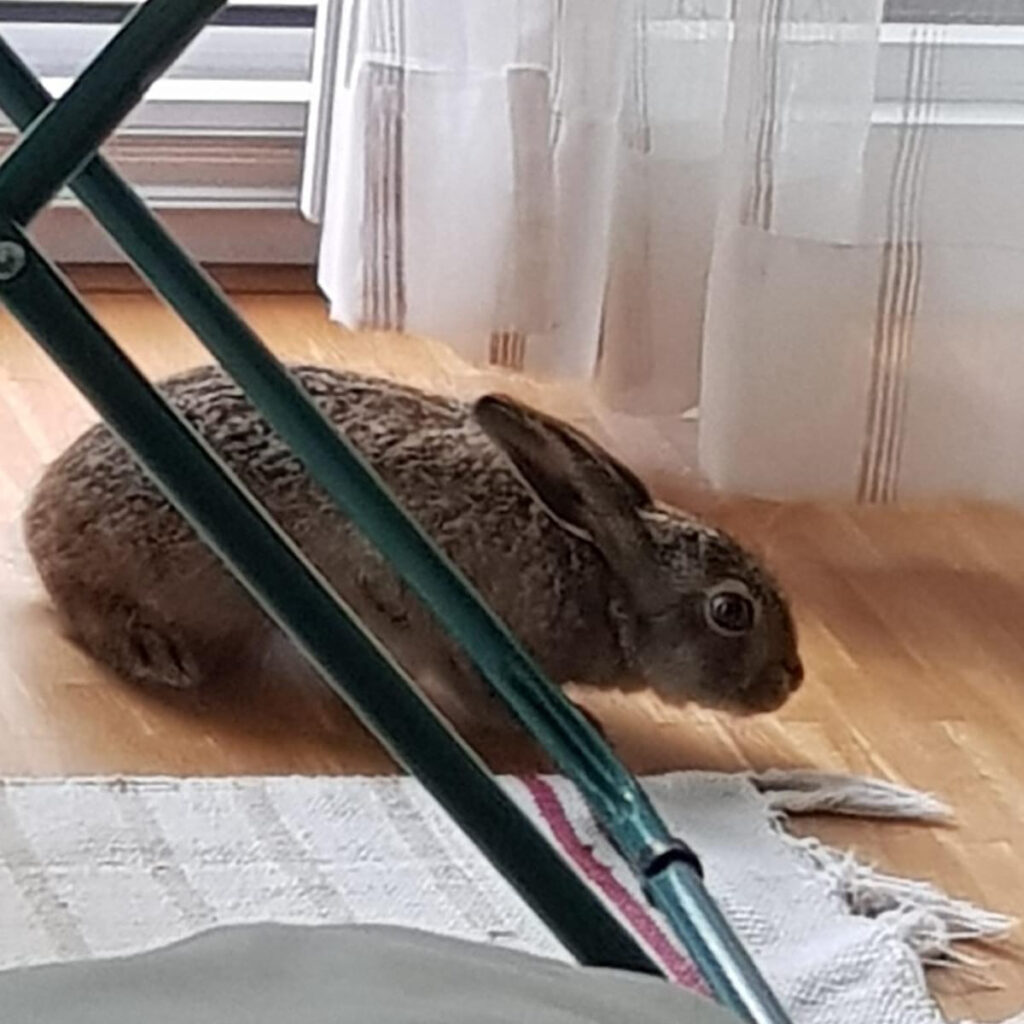
Cities are full of mammals pushed from monoculture-dominated rural areas by lack of habitat, chemical weapons (read: pesticides and herbicides), and dangerous machinery. Once abundant, hare became a threatened species in some parts of central Europe—for example Poland. In some parts of the country they had to be reintroduced by special programs. Patchworks of cultivated, vegetation-rich private properties can make up corridors of diverse mini-ecosystems, thus becoming a tiny huge contributor to preservation. One aspect of animal-free movement has to be considered, though: barriers. When choosing type of boundary protection (fence, wall, hedge, etc.), consider which animals you want to keep out (or in), and which you would likely welcome. Then design accordingly.
Hedgehog bunker
Hedgehogs come and go to the garden. A few times we spied on courting couples. Still, how was I surprised when I discovered that a rhododendron growing by the side of our terrace become a winter nesting spot for a hedgehog. These animals have huge territories to roam in search for insects (high on the menu are vine weevils) and slugs. Even though I voice for protection of nature for the sake of nature, my affection is personal, too. The enemy of my enemy is my friend.
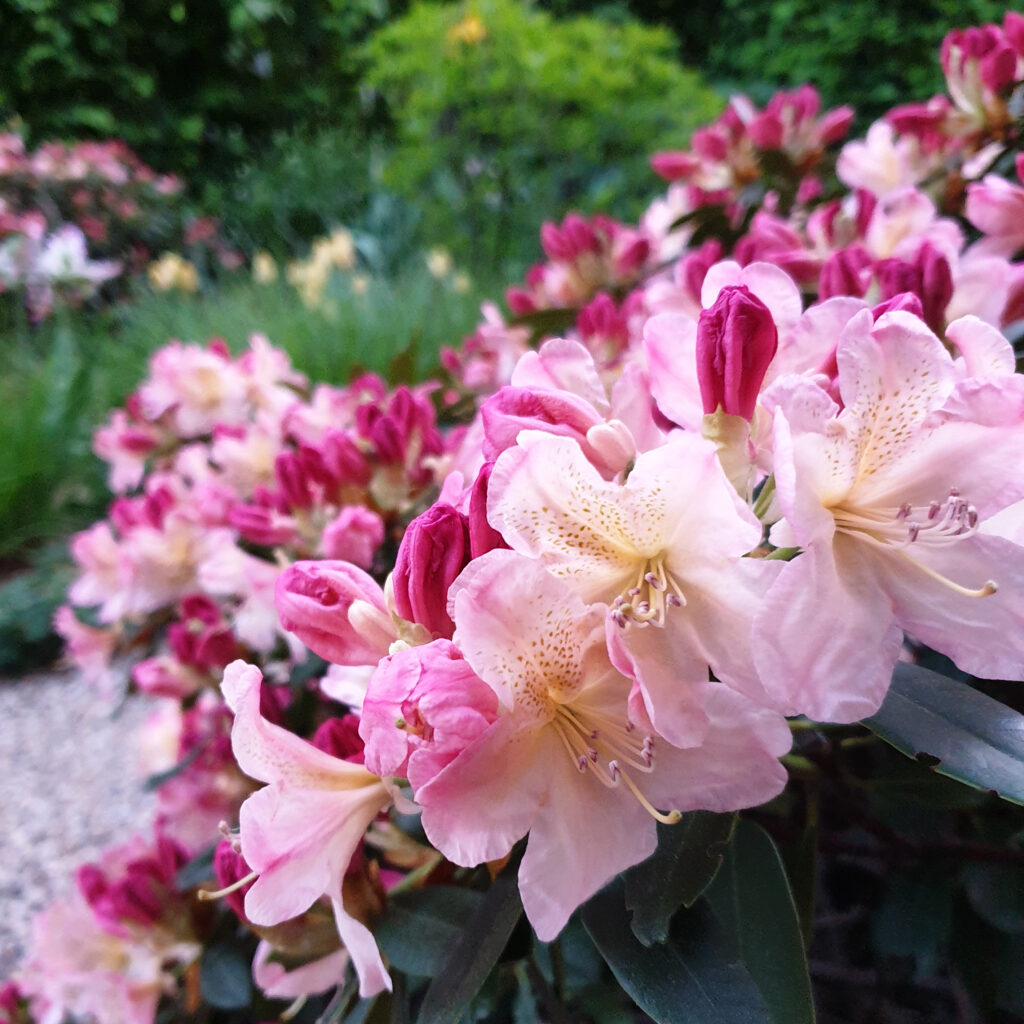
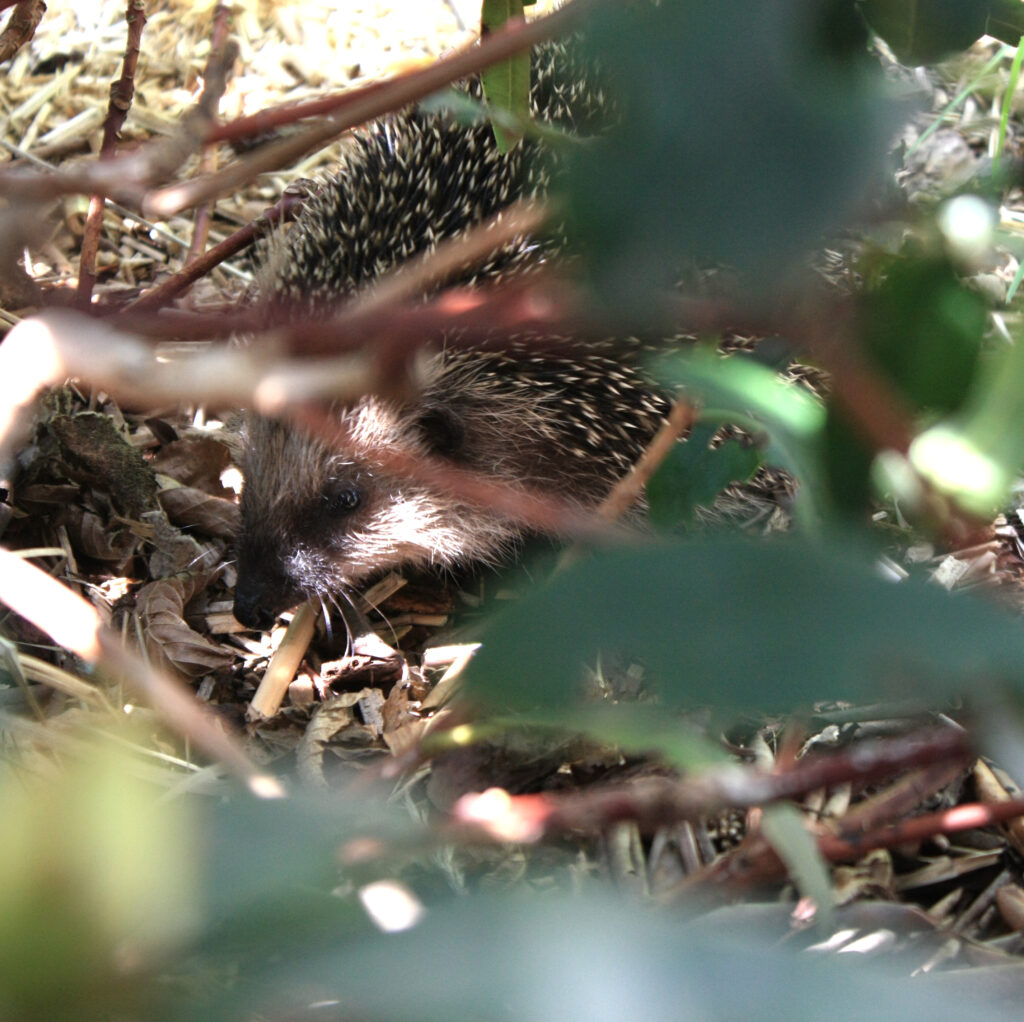
Purists might say that showy rhododendrons are pretty useless garden cultivars—worse even, asian invaders—with no place in a wildlife-friendly garden. Practically, the mounds of evergreen leaves make good umbrellas. The hares liked our rhododendrons during rainy weather, too. Bumble bees frequent the flowers in the spring, not bothered by honey bees, for which rhododendrons are toxic. So maybe not perfect, but our rhododendrons turned good enough for at least a couple of wild animals.
Bird thieves
The latest offspring belonged to a pair of black redstarts. They made a nest within a steel framework of a balcony above our terrace. To build the nest they helped themselves with my moss culture and substrate from orchids, which I moved outside during warm spring weather. When hatchlings arrived, the parents worked themselves up from dawn till dusk, occasionally flying inside the living room. Before returning to the nest, each bird made a stop on top of a garden trellis, proudly presenting the prey: caterpillars, bugs, flies. Visits in the nest were accompanied by a squeaky ruckus of the hatchlings. One day in July the young birds squeezed themselves clumsily out of the construction, and off they went into the world. I could enjoy quiet afternoons again.
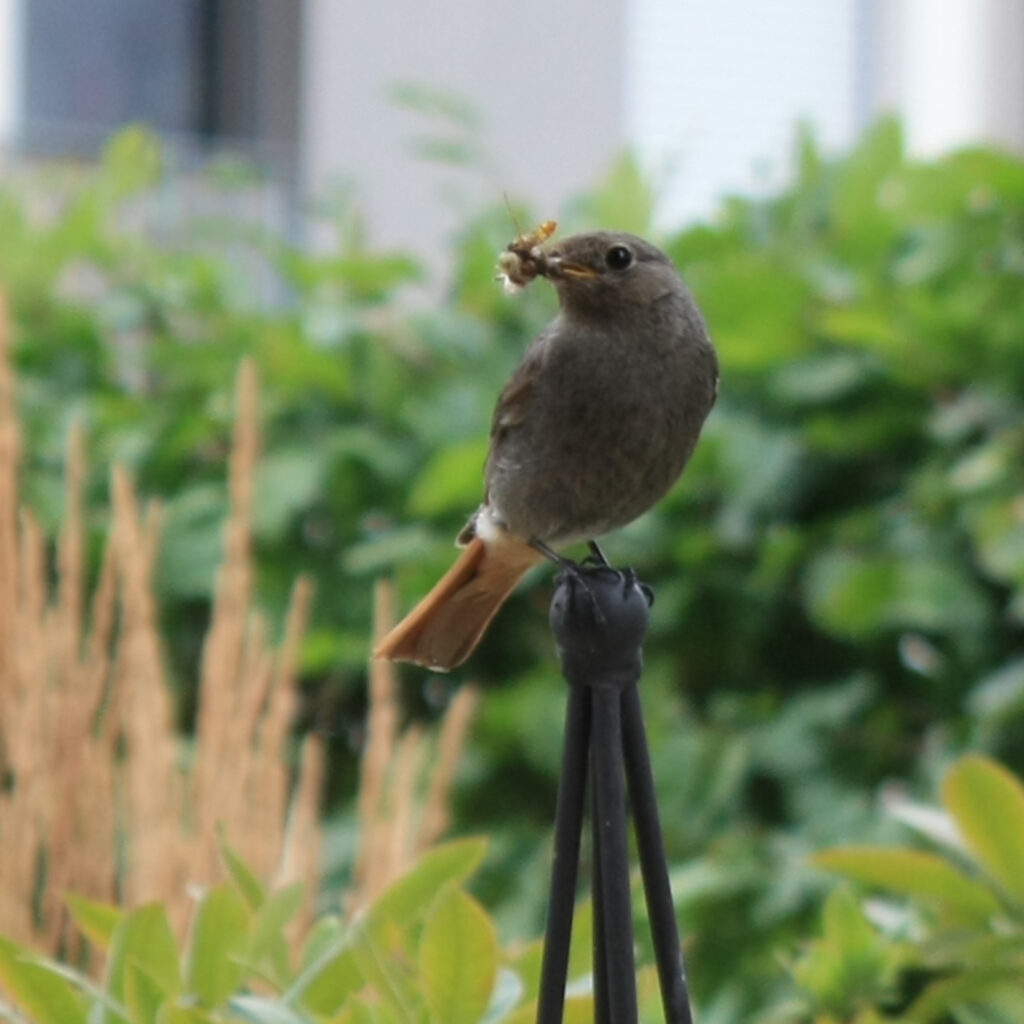
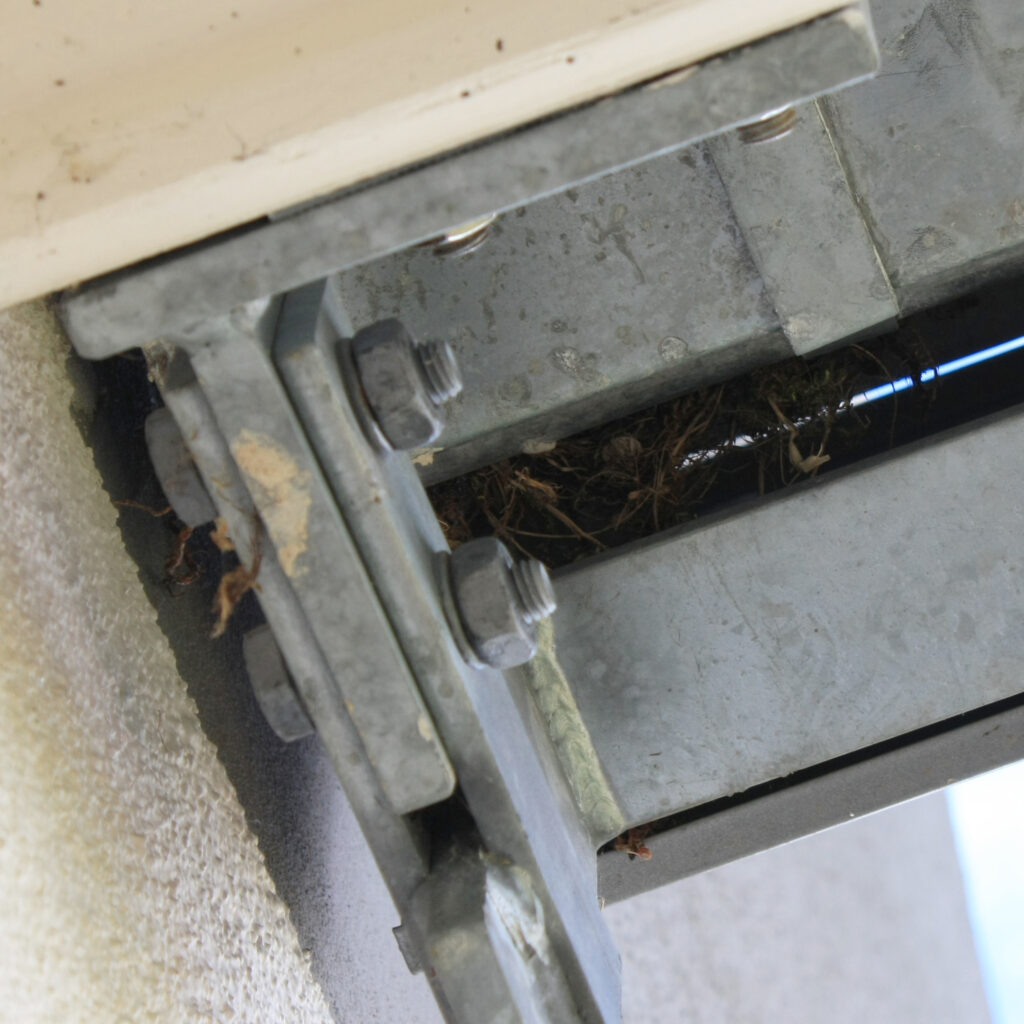
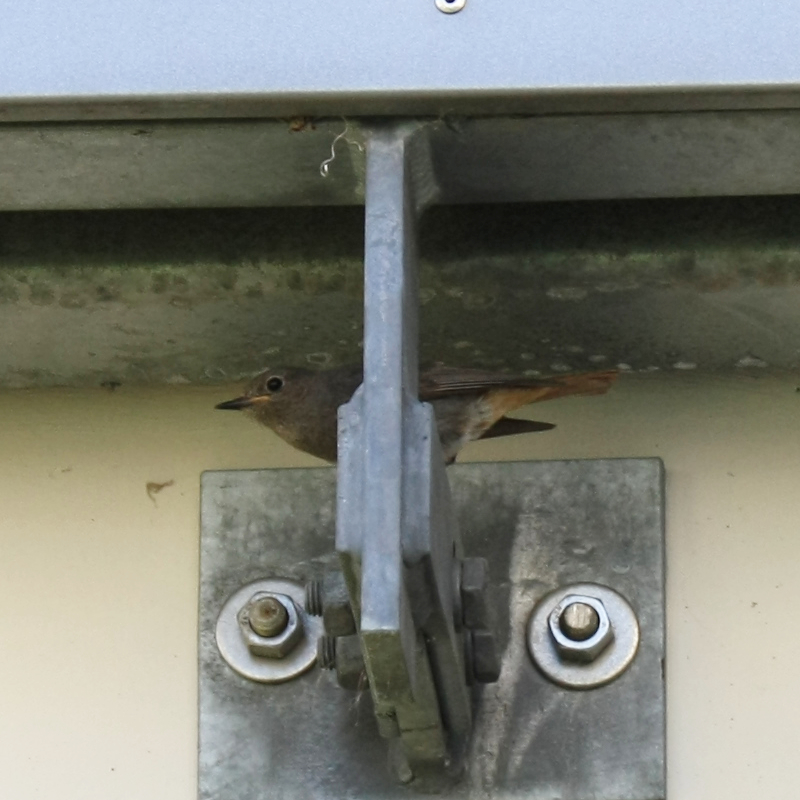
The birds for some reason opted to nest above our terrace, having a choice between dozens of essentially identical spots. Perhaps it was a coincidence. On the other hand, it could also be the fact that the wealth of insects, or seclusion offered by the vegetation, or abundance of watchtowers adapted from trellises and stakes, offered a safer option to rise their precious babies than empty lawns of my neighbours.
Could more be done? Sure! But what have been happening so far in a really small garden in the middle of the city has already been beyond expectations.
Not just bees—natural systems are incredibly rich and complex
As far as wildlife-friendly gardening is concerned, there is a strong bias to focus on pollinators, especially bees. However, wildlife does not equal pollinators, and definitely not just bees. Natural ecosystems—with all the fluidity of the meaning ‘natural’ taken aside for the moment—are made of dense networks of dependencies. Above the ground, plants ‘willingly’ deliver pollen and nectar in exchange for the ability to have sex with their immobile kin. Less willingly, they are being munched and sucked by multitude of other creatures. Insects or spiders, be in their larval or mature forms, munch on these herbivores. Various vertebrates feed on all of the multi-limbal menagerie, becoming a prey themselves for yet higher-order predators. And thus a ‘useless’ full rose might host scores of aphids that feed the larvae of a pollinating hover fly, which will end up as a dinner for a black redtstart.
Underground is not less active than above. Enough to poke a spade in the soil to notice a whirl of worms. Just scratch of the mulch reveals myriad of pill bugs, milli- and centipedes. A careful observer will notice a delicate mesh of fungal filaments. Microbes, fungi, protozoa (a diverse group of unicellular organisms), and microscopic animals, such as various worms and arthropods form a minuscule, yet even more abundant universe intertwined with all larger life forms. Scientist are only now uncovering the roles which these creatures play in ecosystems. Resilience of life within a given ecosystem depends on all its inhabitants, big and tiny. Pollinators, important as they are, cannot exist without the rest of the ecosystem.
What we can and cannot do
It seems a tad arrogant to claim we can intentionally recreate these levels of multifactorial complexity with a spade. On the other hand, we don’t have to. We can create minimal conditions for some of this complexity to develop spontaneously. A multitude of various organisms will colonise the garden, given the opportunity. The opportunities equal places to live, to hide throughout adverse times (for example winter), and to forage. Practically, we throw in plants, mulch and water, and observe what emerges from the garden pot. Meanwhile, more variation in planting and types of habitats tend to deliver more opportunities.
3-minutes practice in gardening for wildlife
You may research what are the best plants in your area to recreate natural species composition as close as possible. It is great if you do, but you don’t have to in order to make a difference. Pressure is a poor advisor. It can be a useful mirror, though. One, in which we can reflect and clearly see the boundaries of our comfort zones.
Note, I don’t intend to undermine the significance of native plants or pure species forms. However, the value of gardening for pleasure shall not be underestimated, too. Even if a garden is set out with purely ornamental intent, it creates niches and opportunities for wildlife. Furthermore, there is no need for a garden to be shabby. It can be elegant and a heaven for animals simultaneously.
I also don’t want to suggest that doing less is the way to go. After all, less is … less. I deliberately didn’t discuss here the research on biodiversity in gardens. We are already flooded by excess of information, which we don’t know how to navigate. Although it may seem counterintuitive, starting from your own needs builds a firm foundation to lasting benefits—for you and for the environment. How much planting is enough? As a rule of a thumb, if you can tend to every individual plant every day, you probably have a capacity to expand your beds. On the other hand, if you cannot reach your tool shed without a machete, you’ve probably gone too far. Everything in between that FEELS manageable is great. Thus, if all you can handle is a small patch of daisies, so be it. If everybody had a patch of daisies, that would make hell lot of flowers. And some happy faces, too.
Gardens, for all intents and purposes, are for pleasure. Nevertheless, one of the most wonderful aspect of gardening is that it serves not just us. I know of no other activity where we can be good while being selfish and excessive. If you plant something, wildlife will come along, in its various manifestations.


